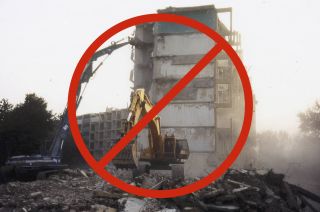
www.buildingsandcities.org/insights/commentaries/stone-ecological-construction-material.html
Stone: An Ecological Construction Material
Could stone help to lower the ecological footprint of buildings?
Summarising a recent research paper, Timothée de Toldi (Bouygues Immobilier SAS) makes a case for the increased use of stone as a building material. In the transition to a low-carbon economy, stone has attractive qualities in terms of durability, low embodied energy, a robust life cycle assessment, and can assist with passive cooling thereby lessening the need for operational energy.
Time for a change in approach

Adapting the building stock to mitigate climate change and be resilient to its effects is a critical urban challenge. For decades, hydrocarbons have shaped both building construction (fuel for product manufacturing, transport, and installation, and petrochemicals for their composition) and operation. Their abundance produced buildings which have light thermal-mass, are often over-glazed (and prone to over-heating) and rely on active cooling which contributes to the increasing frequency of heatwaves. This has resulted in buildings having high associated embodied and operational emissions, estimated to be 33% of global emissions (IEA, 2022).
In this context, the projected decline in EU oil supply (which may face a 20-90% drop by 2050 compared to 2019 (TSP, 2021)) may have two significant impacts. First, the material replacement of deteriorating products and buildings will become more challenging and alternatives hard to find. This will create difficulties for maintaining our buildings easily and could potentially impact living conditions. Second, the reliance on mechanical cooling will become more widespread. This has high fuel and carbon costs. It may strain power grids and intensify heat islands. Access to active cooling may be unequal especially for the most vulnerable people, introducing challenges for social justice issues.
Given the potentially energy-scarce future, buildings constructed today must be designed for extended use and passive comfort in future climates. The adaptaion of the EU building stock (as well as elsewhere) must urgently commence now to reduce climate change impacts and maximise resource efficiency.
Given the above-mentioned situation, the criteria for building material selection and their use needs thought. Key attributes that should be prioritized include: durability, easy maintenance, low embodied energy and carbon footprints, and optimal hygrothermal properties for passive comfort. This may lead to prioritisation of natural over synthetic products. However, to support effective decisions on material selection building sector stakeholders by public entities and industrial ecology roadmaps need better information and more guidance.
Cut-stone: a potential solution?
Alternatives to hydrocarbon synthetic materials will need industrialisation potential, low R&D prerequisites, and the ability to leverage the existing workforce. One such product may be cut-stone. Cut-stone's low embodied fossil energy has been recognized since the post-war energy crisis. Noel (1949) highlighted its minimal requirement - 10 kg coal/m³- compared to concrete - then 225 kg coal/m³), and while alternatives have greatly improved their fuel efficiency (cut-stone Environmental Product Declarations (EPDs) now show only a 50% lower lifecycle volumetric fuel intensity compared to concrete and CLT), its possesses several other key attributes that positions it favorably within industrial ecology frameworks.
High-certainty low-emission
Life-Cycle Assessment (LCA) methodologies assess the carbon footprint of construction methods to inform decisions. However, practitioners and clients need confidence in LCA results and robustness, or there is risk their sustainability achievements and carbon mitigation strategies may be undermined. Complexity in supply chains can introduce uncertainty into product LCAs, however, cut-stone has a relatively simple supply chain.
For instance, the emissions from cut-stone are mostly impacted by variations in the stone's density, which can affect the emissions by around 25% due to the effort needed to cut and transport the stones (CTMNC, 2023), though even the worst case scenario, stone still has around 1.5 to 2.5 times lower emissions than CLT and slag concrete (de Toldi & Pestre, 2023).
Another area of uncertainty in LCA is around opportunity costs. These are low in stone supply chains since the stone has limited benefits when in the ground. However, in timber supply chains this can be much more important, for instance the carbon debt from harvesting a mature tree with a high sequestration rate and planting a younger tree with a lower rate (Peng et al., 2023). Thus, the chosen methodology and interpretation of an LCA can influence if a product is perceived as low, or high carbon.
The assumptions placed on the impact of industrial byproducts in LCA is also an area of uncertainty. For instance, by-products from industrial processes can sometimes be used to replace cement, which can make some concretes lower carbon, though there will always be uncertainty associated with which allocation methodologies have been used. Indeed, some studies show a possible thirtyfold variation in embodied emissions for blast furnace slag, meaning that the benefit of using by-products in a product LCA could be great or small depending on how it is measured (Buttiens et al., 2016).
Thus, having a simple supply chain without these uncertainties gives greater confidence in LCA for cut-stone. Recent EPDs suggest this could cut emissions fourfold compared to typical low-carbon concretes (INIES, 2023a, 2023b). In addition, unlike other material production processes, cut-stone processing can be relatively simply electrified. Light extraction and cutting machinery account for half of cut-stone emissions. A quarter of emissions stem from workshop cutting of oversized stone. Cut-stone's emissions will fall as electricity is decarbonized. Reintroducing multi-disc quarry cutters could see emissions fall further.
Low biodiversity impact
Cut-stone quarries are often currently underutilized (de Toldi & Pestre, 2023) and cut-stone can also come from converted solid-rock aggregate quarries, meaning land use change is not currently a significant impact for cut-stone. Introducing new quarries will bring more environmental impact; the primary biodiversity impact for stone quarries stems from topsoil loss in new open-air quarries. However, alternatives have similar land use impacts, indeed concrete requires five different quarry types; limestone, sand, and aggregate as well as iron for rebars, and coal for clinker calcination, each with its own environmental impact. Similarly timber extraction can also have significant biodiversity impacts through forest clearing and monoculture plantations. Moreover, some studies suggest that since cut-stone has a higher intensity of resource extraction per unit area (approximately 3,000 times higher than timber, after adjusting for material requirements per housing unit1) when used in construction it is likely that stone will have lower land use impacts than its alternatives (WRI, 2023).
Material benefits
Cut-stone has exceptional durability. Its structural performance and fire resilience endure over its lifetime. It naturally ages without compromising aesthetic appeal. It can be maintained and restored relatively simply by local skilled workers.
Stone is part of the vernacular in some areas. It has cultural significance for placemaking, fostering community wellbeing and building preservation.
Cut-stone has high thermal-mass, which means it can contribute to provide passive and cost-effective mitigation to overheating in the summer by absorbing internal heat gains during the day and discharging at night, thereby making buildings cooler, and less likely to need active cooling. This will become increasingly important in a future warmer climate.
A wake-up call
Cut-stone faces several challenges. Public opposition to quarrying (NIMBYism) is important and even though cut-stone quarries can be relatively lower impact than aggregate quarries, this differentiation is nuanced (Ioannidou et al., 2015). There are also challenges in that there are currently no distinct Eurocode classifications for large cut-stone elements, meaning they are grouped with smaller masonry units which have less favourable design safety factors. The cost of cut-stone is one of the greatest barriers, though this is something that may improve with greater economies of scale.
These challenges may be surmountable, especially as durability, climate adaptation and environmental impact become more important in decision making. Cut-stone could move beyond its current use primarily for aesthetic cladding and become a viable solution for cities to mitigate and adapt to climate change, and return it to its historical role as a mainstream and competitive sustainable construction material.
Note
1.Assuming a 5-meter annual quarrying depth and 50% rejection rate for stone, and average standing volumes of 1,500 trees per hectare with 50-year rotation periods, 0.7 m3 stem volumes, and 20% stem suitability for cross-laminated timber sawing units. Then corrected to account for double volume requirements in the case of stone.
References
Buttiens, K., Leroy, J., Negro, P., Thomas, J.-S., Edwards, K., & De Lassat, Y. (2016). The carbon cost of slag production in the blast furnace: a scientific approach. Journal of Sustainable Metallurgy, 2(1), 62-72. https://doi.org/10.1007/s40831-016-0046-8
CTMNC. (2023). Cut-stone EPD generator. https://www.ctmnc.polaris-creations.fr/wp-content/uploads/2022/12/Calculette_carbone_produits_pierre_v2.0_7_CTMNC_2022.xlsm
de Toldi, T., & Pestre, T. (2023). The relevance of cut-stone to strategies for low-carbon buildings. Buildings and Cities. https://doi.org/10.5334/bc.278
EGDI. (2024). Pan-European surface geology. https://data.geus.dk/egdi/?mapname=egdi_new_structure#baslay=baseMapGEUS&extent=832948.930251969,859932.0361846776,7898427.887322219,4609787.795171441&layers=onegeoeuro_surface_lithology
IEA. (2022). Buildings. https://www.iea.org/energy-system/buildings
INIES. (2023a). id: 34330 (Carrieres de Noyant). https://www.base-inies.fr/iniesV4/dist/infos-produit
INIES. (2023b). id: 35395 (Carrieres de Vassens). https://www.base-inies.fr/iniesV4/dist/consultation.html?id=35395
Ioannidou, D., Nikias, V., Brière, R., Zerbi, S., & Habert, G. (2015). Land-cover-based indicator to assess the accessibility of resources used in the construction sector. Resources, Conservation and Recycling, 94, 80-91. https://doi.org/10.1016/j.resconrec.2014.11.006
Noel, P. (1949). La pierre matériau du passé et de l'avenir,.Paris: Institut technique du bâtiment et des travaux publics. p.109.
Peng, L., Searchinger, T. D., Zionts, J., & Waite, R. (2023). The carbon costs of global wood harvests. Nature, 620(7972), 110-115. https://doi.org/10.1038/s41586-023-06187-1
The Shift Project (TSP). (2021). Approvisionnement pétrolier futur de l'Union Européenne:état des réserves et perspectives de production des principaux pays fournisseurs (The future of oil supply in the European Union). https://theshiftproject.org/wp-content/uploads/2021/05/Approvisionnement-petrolier-futur-de-lUE_Shift-Project_Mai-2021_RAPPORT-COMPLET.pdf
WRI. (2023). The global land squeeze: managing the growing competition for land. https://www.wri.org/research/global-land-squeeze-managing-growing-competition-land
Latest Peer-Reviewed Journal Content
Youth engagement in urban living labs: tools, methods and pedagogies
N Charalambous, C Panayi, C Mady, T Augustinčić & D Berc
Co-creating urban transformation: a stakeholder analysis for Germany’s heat transition
P Heger, C Bieber, M Hendawy & A Shooshtari
Placemaking living lab: creating resilient social and spatial infrastructures
M Dodd, N Madabhushi & R Lees
Church pipe organs: historical tuning records as indoor environmental evidence
B Bingley, A Knight & Y Xing
A framework for 1.5°C-aligned GHG budgets in architecture
G Betti, I Spaar, D Bachmann, A Jerosch-Herold, E Kühner, R Yang, K Avhad & S Sinning
Net zero retrofit of the building stock [editorial]
D Godoy-Shimizu & P Steadman
Co-learning in living labs: nurturing civic agency and resilience
A Belfield
The importance of multi-roles and code-switching in living labs
H Noller & A Tarik
Researchers’ shifting roles in living labs for knowledge co-production
C-C Dobre & G Faldi
Increasing civic resilience in urban living labs: city authorities’ roles
E Alatalo, M Laine & M Kyrönviita
Co-curation as civic practice in community engagement
Z Li, M Sunikka-Blank, R Purohit & F Samuel
Preserving buildings: emission reductions from circular economy strategies in Austria
N Alaux, V Kulmer, J Vogel & A Passer
Urban living labs: relationality between institutions and local circularity
P Palo, M Adelfio, J Lundin & E Brandão
Living labs: epistemic modelling, temporariness and land value
J Clossick, T Khonsari & U Steven
Co-creating interventions to prevent mosquito-borne disease transmission in hospitals
O Sloan Wood, E Lupenza, D M Agnello, J B Knudsen, M Msellem, K L Schiøler & F Saleh
Circularity at the neighbourhood scale: co-creative living lab lessons
J Honsa, A Versele, T Van de Kerckhove & C Piccardo
Positive energy districts and energy communities: how living labs create value
E Malakhatka, O Shafqat, A Sandoff & L Thuvander
Built environment governance and professionalism: the end of laissez-faire (again)
S Foxell
Co-creating justice in housing energy transitions through energy living labs
D Ricci, C Leiwakabessy, S van Wieringen, P de Koning & T Konstantinou
HVAC characterisation of existing Canadian buildings for decarbonisation retrofit identification
J Adebisi & J J McArthur
Simulation and the building performance gap [editorial]
M Donn
Developing criteria for effective building-sector commitments in nationally determined contributions
P Graham, K McFarlane & M Taheri
Join Our Community

The most important part of any journal is our people – readers, authors, reviewers, editorial board members and editors. You are cordially invited to join our community by joining our mailing list. We send out occasional emails about the journal – calls for papers, special issues, events and more.
We will not share your email with third parties. Read more



Latest Commentaries
COP30 Report
Matti Kuittinen (Aalto University) reflects on his experience of attending the 2025 UN Conference of the Parties in Belém, Brazil. The roadmaps and commitments failed to deliver the objectives of the 2025 Paris Agreement. However, 2 countries - Japan and Senegal - announced they are creating roadmaps to decarbonise their buildings. An international group of government ministers put housing on the agenda - specifying the need for reduced carbon and energy use along with affordability, quality and climate resilience.
Building-Related Research: New Context, New Challenges
Raymond J. Cole (University of British Columbia) reflects on the key challenges raised in the 34 commissioned essays for Buildings & Cities 5th anniversary. Not only are key research issues identified, but the consequences of changing contexts for conducting research and tailoring its influence on society are highlighted as key areas of action.